[Editor’s Note: Army Mad Scientist is pleased to present our latest episode of The Convergence podcast, featuring General Charles A. Flynn, Commanding General, U.S. Army Pacific (USARPAC), discussing the unique pacing threat posed by China, building interoperability with partner nations, and the future of multi-domain operations in INDOPACOM — Enjoy!]
[If the podcast dashboard is not rendering correctly for you, please click here to listen to the podcast.]
 General Charles A. Flynn assumed command of the United States Army’s largest Service Component Command, U.S. Army Pacific (USARPAC), on June 4, 2021. USARPAC is headquartered at Fort Shafter, Hawaii, with portions of the command-forward deployed and based throughout the Indo-Pacific. Gen. Flynn comes to Fort Shafter after serving as Deputy Chief of Staff for Army Operations, Plans, and Training at the Pentagon. Gen. Flynn has served in a variety of command, staff, and leadership positions from platoon leader to division commander.
General Charles A. Flynn assumed command of the United States Army’s largest Service Component Command, U.S. Army Pacific (USARPAC), on June 4, 2021. USARPAC is headquartered at Fort Shafter, Hawaii, with portions of the command-forward deployed and based throughout the Indo-Pacific. Gen. Flynn comes to Fort Shafter after serving as Deputy Chief of Staff for Army Operations, Plans, and Training at the Pentagon. Gen. Flynn has served in a variety of command, staff, and leadership positions from platoon leader to division commander.
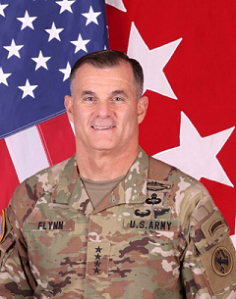 Gen. Flynn is a native of Middletown, Rhode Island and Distinguished Military Graduate from the University of Rhode Island with a BS in Business Management. General Flynn is a graduate of the Infantry Officer Basic and Advanced Courses at Fort Benning, GA. He holds two master’s degrees, one in National Security and Strategic Studies from the United States Naval War College in Newport, RI, and one in Joint Campaign Planning and Strategy from the National Defense University.
Gen. Flynn is a native of Middletown, Rhode Island and Distinguished Military Graduate from the University of Rhode Island with a BS in Business Management. General Flynn is a graduate of the Infantry Officer Basic and Advanced Courses at Fort Benning, GA. He holds two master’s degrees, one in National Security and Strategic Studies from the United States Naval War College in Newport, RI, and one in Joint Campaign Planning and Strategy from the National Defense University.
In today’s interview, Gen. Flynn discusses the unique pacing threat posed by China, building interoperability with partner nations, and the future of multi-domain operations in INDOPACOM. The following bullet points highlight some of the key insights from our interview:
-
-
-
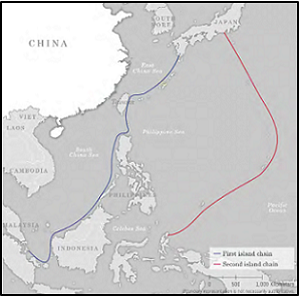
The PLA’s Anti-Access/Area Denial (A2/AD) capabilities are robust within the First Island Chain (shown here in blue), and China seeks to strengthen its capabilities to reach farther into the Pacific Ocean (the Second Island Chain is shown here in red). / Source: Defense Intelligence Agency, China Military Power While it is often argued that future conflicts in the Pacific will be fought in the air and at sea, the U.S. Army remains critical in securing our regional interests. The Army continues to build relationships with partners on land, and will likely be the only Service not hindered by China’s Anti-Access /Area Denial (A2/AD) system, which is not designed to find, fix, and destroy land forces. As a result, land power will serve as a counterweight to Chinese aspirations both regionally and globally.
-
-
-
-
-
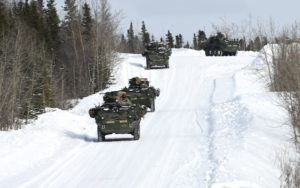
Arctic Wolves enter the fight! Strykers from 3rd Battalion, 21st Infantry Regiment move down a snowy road in the Donnelly Training Area during Joint Pacific Multinational Readiness Center (JPMRC) 22-02. This was the first Home Station-Combat Training Center rotation in Alaska, enabling U.S. and Canadian forces to train for Large Scale Combat Operations in an Arctic environment. The Army’s Joint Pacific Multinational Readiness Center (JPMRC) integrates live, virtual, and constructive environments, enabling our forces and partners to conduct training via a mobile, regional training center in the Pacific’s Arctic, Jungle, and Archipelago conditions and environments. JPMRC enables the Army to maintain a constant presence in the region, train, and build readiness with our allies and partners.
-
-
-
-
-

U.S. Army Soldiers from the 130th Engineer Brigade and 8th Military Police Brigade train with the Papua New Guinea (PNG) Defense Forces on care under fire, convoy security, individual movement techniques, and formations as fire teams in Port Moresby during Tamiok Strike 22 , a bilateral Army to Army military exercise between USARPAC and the PNG forces. While training with technology in the region of operation is important, relationships matter. Building strong relationships between individuals, organizations, and countries is vital for deterrence by denial. We rely on our allies and partners for their understanding of the geography and the human terrain — the cultures, the societies, and the peoples of the region.
-
-
-
-
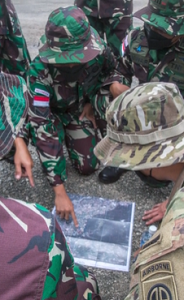 There are three types of interoperability: human, technical, and procedural. There are also three dimensions: human, physical, and information. The crossover or intersection between interoperability and dimensions is the human. By focusing on the human dimension and investing in and building human interoperability with our allies and partners, other vital components of interoperability will follow.
There are three types of interoperability: human, technical, and procedural. There are also three dimensions: human, physical, and information. The crossover or intersection between interoperability and dimensions is the human. By focusing on the human dimension and investing in and building human interoperability with our allies and partners, other vital components of interoperability will follow.
-
-
-
-
There are four principles for successful network integration. First, it will require an open architecture so Joint forces and mission partners may easily plug into it. Second, there must be a better way to both grant and evaluate the risk of granting authority to operate within these
 frameworks. Next, the Army needs to be more data-centric. Finally, our forces need to become transport agnostic for our data.
frameworks. Next, the Army needs to be more data-centric. Finally, our forces need to become transport agnostic for our data.
-
-
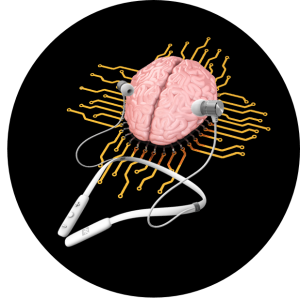 Stay tuned to the Mad Scientist Laboratory for our next episode of The Convergence podcast featuring COL Stefan Banach (USA-Ret.), Director, Army Management Staff College, returning to discuss non-terrestrial warfare, weapons of mass deception, and the future information environment.
Stay tuned to the Mad Scientist Laboratory for our next episode of The Convergence podcast featuring COL Stefan Banach (USA-Ret.), Director, Army Management Staff College, returning to discuss non-terrestrial warfare, weapons of mass deception, and the future information environment.
If you enjoyed this post, learn more about China as our Pacing Threat at the TRADOC G-2‘s China Landing Zone
… check out the wealth of regional training information on the TRADOC G-2‘s DATE World Pacific page
… explore future conflict possibilities in this region:
“No Option is Excluded” — Using Wargaming to Envision a Chinese Assault on Taiwan, by Ian Sullivan
The U.S. Joint Force’s Defeat before Conflict, by CPT Anjanay Kumar
Guns of August 2035 – “Ferdinand Visits the Kashmir”: A Future Strategic and Operational Environment by Team RSM3 from the Army Futures Study Group Cohort VI
Shén fēng: Military Use of Weather Modification Technology, by Rory Fedorochko
… and review the following additional Operational Environment content:
The Operational Environment (2021-2030): Great Power Competition, Crisis, and Conflict, along with its source document
How China Fights and associated podcast
China’s PLA Modernization through the DOTMLPF-P Lens, by Dr. Jacob Barton
The Hermit Kingdom in the Digital Era: Implications of the North Korean Problem for the SOF Community, by Colonel Montgomery Erfourth and Dr. Aaron Bazin
Competition and Conflict in the Next Decade
Disrupting the “Chinese Dream” – Eight Insights on how to win the Competition with China
Competition in 2035: Anticipating Chinese Exploitation of Operational Environments
Disclaimer: The views expressed in this blog post do not necessarily reflect those of the U.S. Department of Defense, Department of the Army, Army Futures Command (AFC), or Training and Doctrine Command (TRADOC).



